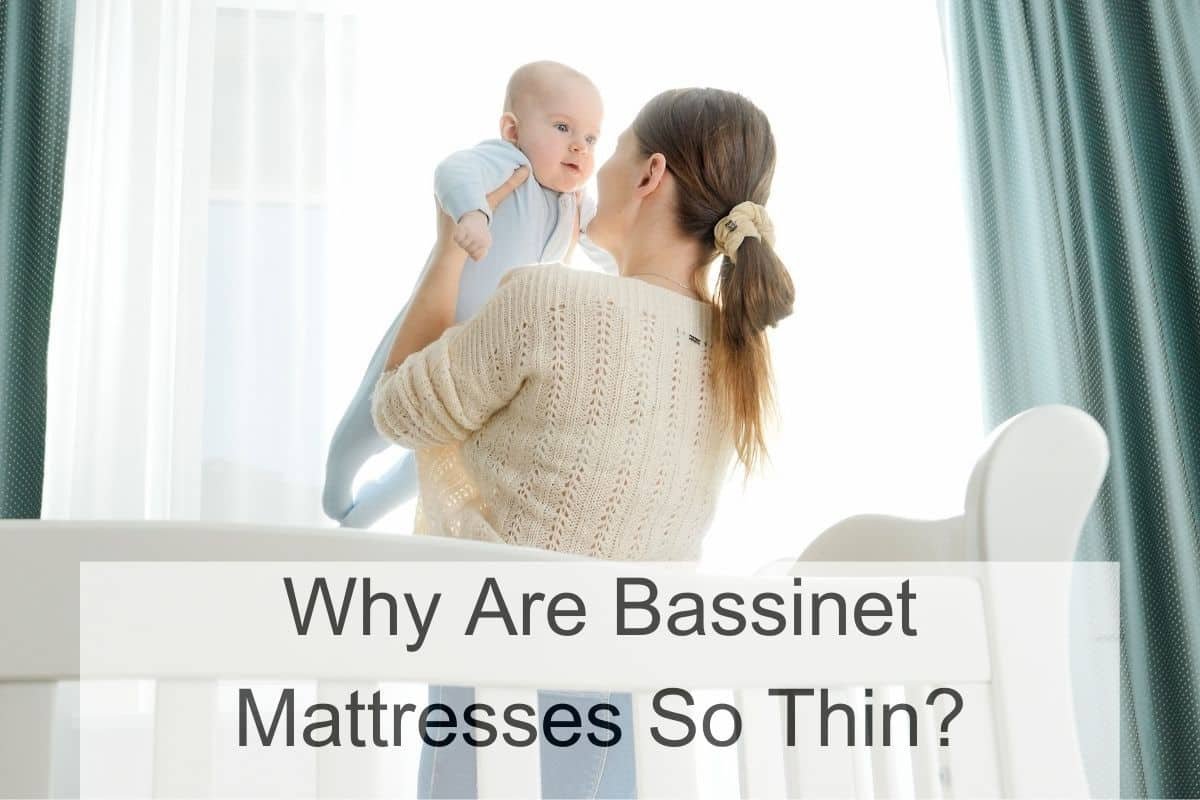I’ve been asked before why bassinet mattresses are so thin. After doing some research, I found that the main reason is safety. A thin and firm bassinet mattress is safe for your baby. A thick, soft, plush mattress can be dangerous for newborns who can’t move around or turn their heads from side to side. They can sink into a thick mattress and if they’re stuck and can’t turn their heads away, it can lead to suffocation. Another reason for the thinness of bassinet mattresses is to prevent entrapment. According to Adaptable Mama, bassinet mattresses are thin to prevent the baby’s entrapment between the mattress and the bassinet’s wall. This is particularly important in bassinets with soft, flexible mesh sides. Mesh sides are great for better breathability and even reduce the risk of Sudden Infant Death Syndrome (SIDS). A thin mattress also allows air to directly reach your baby’s body without any disturbance, which can prevent overheating.Safety Considerations
Another reason for the thinness of bassinet mattresses is to prevent entrapment. According to Adaptable Mama, bassinet mattresses are thin to prevent the baby’s entrapment between the mattress and the bassinet’s wall. This is particularly important in bassinets with soft, flexible mesh sides. Mesh sides are great for better breathability and even reduce the risk of Sudden Infant Death Syndrome (SIDS). A thin mattress also allows air to directly reach your baby’s body without any disturbance, which can prevent overheating.Safety Considerations As a parent, I understand the importance of ensuring that my baby is safe and secure at all times. When it comes to bassinet mattresses, safety is a top priority. In this section, I will discuss some of the safety considerations that parents should keep in mind when selecting a bassinet mattress.SIDS Prevention GuidelinesSudden Infant Death Syndrome (SIDS) is a serious concern for parents, and it is important to take steps to reduce the risk of SIDS. The American Academy of Pediatrics (AAP) recommends that parents follow the ABCs of safe sleep: babies should sleep Alone, on their Backs, and in a Crib or bassinet that meets safety standards.One of the ways that bassinet mattresses help prevent SIDS is by being thin and firm. According to Upside Dad, a thin and firm mattress reduces the risk of suffocation and ensures that the baby’s airway remains open.Firmness and SupportAnother important consideration when it comes to bassinet mattresses is firmness and support. A firm mattress provides the necessary support for a baby’s developing bones and helps prevent the risk of SIDS. According to Adaptable Mama, parents should avoid stacking two mattresses or putting anything soft on the mattress, as this can increase the risk of suffocation.Design and Functionality
As a parent, I understand the importance of ensuring that my baby is safe and secure at all times. When it comes to bassinet mattresses, safety is a top priority. In this section, I will discuss some of the safety considerations that parents should keep in mind when selecting a bassinet mattress.SIDS Prevention GuidelinesSudden Infant Death Syndrome (SIDS) is a serious concern for parents, and it is important to take steps to reduce the risk of SIDS. The American Academy of Pediatrics (AAP) recommends that parents follow the ABCs of safe sleep: babies should sleep Alone, on their Backs, and in a Crib or bassinet that meets safety standards.One of the ways that bassinet mattresses help prevent SIDS is by being thin and firm. According to Upside Dad, a thin and firm mattress reduces the risk of suffocation and ensures that the baby’s airway remains open.Firmness and SupportAnother important consideration when it comes to bassinet mattresses is firmness and support. A firm mattress provides the necessary support for a baby’s developing bones and helps prevent the risk of SIDS. According to Adaptable Mama, parents should avoid stacking two mattresses or putting anything soft on the mattress, as this can increase the risk of suffocation.Design and Functionality As a parent, I understand the importance of selecting the right bassinet for my baby. One of the most common questions I had was why are bassinet mattresses so thin? After doing some research, I found out that there are several reasons for this design choice.Space EfficiencyBassinets are designed to be compact and space-efficient. A thin mattress allows for more space inside the bassinet, which is especially important for smaller living spaces. Additionally, a thin mattress ensures that the baby is not too high off the ground, which reduces the risk of falls.PortabilityAnother reason why bassinet mattresses are thin is to make them more portable. Thin mattresses are lightweight and easy to move around, which is convenient for parents who want to keep their baby close by. A thin mattress also makes it easier to fold up and store the bassinet when not in use.Material and Construction
As a parent, I understand the importance of selecting the right bassinet for my baby. One of the most common questions I had was why are bassinet mattresses so thin? After doing some research, I found out that there are several reasons for this design choice.Space EfficiencyBassinets are designed to be compact and space-efficient. A thin mattress allows for more space inside the bassinet, which is especially important for smaller living spaces. Additionally, a thin mattress ensures that the baby is not too high off the ground, which reduces the risk of falls.PortabilityAnother reason why bassinet mattresses are thin is to make them more portable. Thin mattresses are lightweight and easy to move around, which is convenient for parents who want to keep their baby close by. A thin mattress also makes it easier to fold up and store the bassinet when not in use.Material and Construction When it comes to bassinet mattresses, the material and construction are crucial factors to consider. As a parent, you want to ensure that your baby is comfortable and safe while sleeping.BreathabilityOne important aspect of bassinet mattresses is breathability. Babies are not able to regulate their body temperature as well as adults, so it’s important to ensure that their sleeping environment is not too hot or stuffy. Bassinet mattresses that are made with breathable materials, such as cotton or natural latex, can help prevent overheating and improve air circulation.Ease of CleaningAnother factor to consider is the ease of cleaning. Babies can be messy, and accidents can happen during diaper changes or feeding times. A bassinet mattress that is easy to clean can save you time and hassle. Look for mattresses that have removable covers that can be machine washed or wiped down easily. Some mattresses even come with waterproof covers to protect against spills and accidents.Regulations and Standards
When it comes to bassinet mattresses, the material and construction are crucial factors to consider. As a parent, you want to ensure that your baby is comfortable and safe while sleeping.BreathabilityOne important aspect of bassinet mattresses is breathability. Babies are not able to regulate their body temperature as well as adults, so it’s important to ensure that their sleeping environment is not too hot or stuffy. Bassinet mattresses that are made with breathable materials, such as cotton or natural latex, can help prevent overheating and improve air circulation.Ease of CleaningAnother factor to consider is the ease of cleaning. Babies can be messy, and accidents can happen during diaper changes or feeding times. A bassinet mattress that is easy to clean can save you time and hassle. Look for mattresses that have removable covers that can be machine washed or wiped down easily. Some mattresses even come with waterproof covers to protect against spills and accidents.Regulations and Standards As a parent, it’s important to ensure that the bassinet mattress you choose is safe for your baby. Luckily, there are regulations and standards in place to help guide your decision-making process.Consumer Product Safety CommissionThe Consumer Product Safety Commission (CPSC) is a government agency that sets safety standards for consumer products, including bassinet mattresses. In 2022, the CPSC approved a new federal safety standard for crib mattresses, which will also apply to after-market mattresses used in play yards and portable cribs CPSC. This standard aims to reduce the risk of asphyxiation and suffocation by addressing design-related issues and mattress compression.ASTM International StandardsASTM International is a global organization that develops and publishes technical standards for a wide range of products, including bassinet mattresses. ASTM F2194-13 is the current standard for bassinet mattresses, which includes requirements for size, firmness, and labeling. The standard also addresses issues such as entrapment, suffocation, and strangulation hazards.Parental PreferencesAs a parent, I understand the importance of choosing the right bassinet mattress for my baby. I want my baby to be comfortable, safe, and secure while sleeping. In my search for the perfect bassinet mattress, I found that parental preferences vary based on cultural practices, comfort perception, and safety concerns.Comfort PerceptionSome parents prefer a soft and plush mattress for their baby’s bassinet, while others prefer a thin and firm one. According to Bliss of Parent, thin and hard mattresses allow air to reach your baby’s body without any disturbance, preventing overheating. Additionally, thin mattresses can absorb moisture and dry quickly, preventing a damp environment.On the other hand, some parents believe that a soft and plush mattress provides more comfort to their baby. However, it’s important to note that the American Academy of Pediatrics recommends a firm mattress for safe sleep to reduce the risk of Sudden Infant Death Syndrome (SIDS).Cultural PracticesCultural practices can also influence parental preferences for bassinet mattresses. For example, some cultures believe that a hard mattress is better for a baby’s spine development, while others believe that a soft mattress provides more comfort. It’s important to consider cultural practices when choosing a bassinet mattress, but safety should always be the top priority.
As a parent, it’s important to ensure that the bassinet mattress you choose is safe for your baby. Luckily, there are regulations and standards in place to help guide your decision-making process.Consumer Product Safety CommissionThe Consumer Product Safety Commission (CPSC) is a government agency that sets safety standards for consumer products, including bassinet mattresses. In 2022, the CPSC approved a new federal safety standard for crib mattresses, which will also apply to after-market mattresses used in play yards and portable cribs CPSC. This standard aims to reduce the risk of asphyxiation and suffocation by addressing design-related issues and mattress compression.ASTM International StandardsASTM International is a global organization that develops and publishes technical standards for a wide range of products, including bassinet mattresses. ASTM F2194-13 is the current standard for bassinet mattresses, which includes requirements for size, firmness, and labeling. The standard also addresses issues such as entrapment, suffocation, and strangulation hazards.Parental PreferencesAs a parent, I understand the importance of choosing the right bassinet mattress for my baby. I want my baby to be comfortable, safe, and secure while sleeping. In my search for the perfect bassinet mattress, I found that parental preferences vary based on cultural practices, comfort perception, and safety concerns.Comfort PerceptionSome parents prefer a soft and plush mattress for their baby’s bassinet, while others prefer a thin and firm one. According to Bliss of Parent, thin and hard mattresses allow air to reach your baby’s body without any disturbance, preventing overheating. Additionally, thin mattresses can absorb moisture and dry quickly, preventing a damp environment.On the other hand, some parents believe that a soft and plush mattress provides more comfort to their baby. However, it’s important to note that the American Academy of Pediatrics recommends a firm mattress for safe sleep to reduce the risk of Sudden Infant Death Syndrome (SIDS).Cultural PracticesCultural practices can also influence parental preferences for bassinet mattresses. For example, some cultures believe that a hard mattress is better for a baby’s spine development, while others believe that a soft mattress provides more comfort. It’s important to consider cultural practices when choosing a bassinet mattress, but safety should always be the top priority.
Why Are Bassinet Mattresses So Thin?

